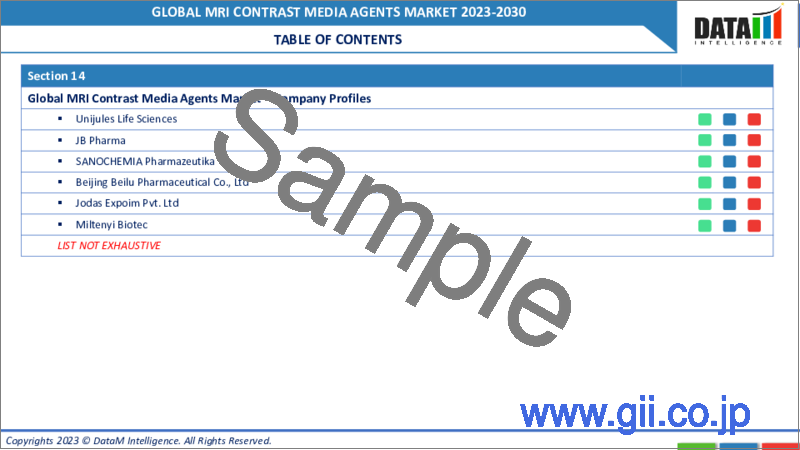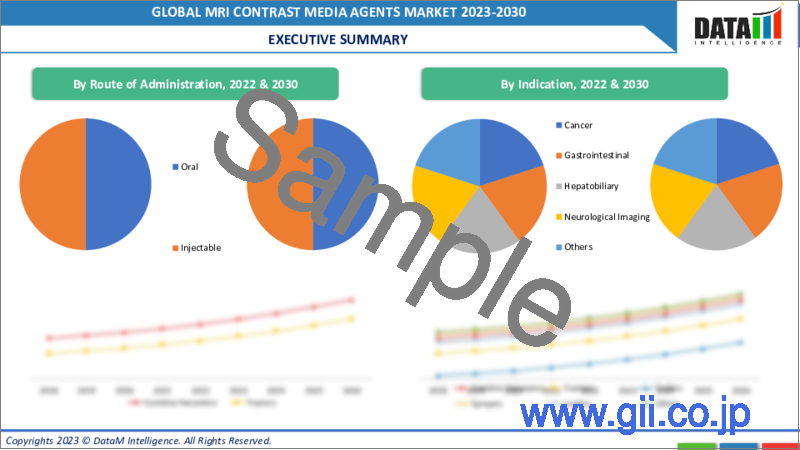|
|
市場調査レポート
商品コード
1316235
MRI造影剤の世界市場:2023年~2030年Global MRI Contrast Media Agents Market - 2023-2030 |
||||||
カスタマイズ可能
適宜更新あり
|
|||||||
| MRI造影剤の世界市場:2023年~2030年 |
|
出版日: 2023年07月27日
発行: DataM Intelligence
ページ情報: 英文 195 Pages
納期: 即日から翌営業日
|
- 全表示
- 概要
- 目次
市場概要
世界のMRI造影剤市場は2022年に21億米ドルに達し、2030年には35億米ドルに達するなど、有利な成長が見込まれています。世界のMRI造影剤市場は、予測期間中(2023~2030年)に6.9%のCAGRを示すと予測されています。
高磁場MRIシステム、マルチパラメトリックイメージング、機能的MRIなどのMRI技術の向上により、MRIの臨床用途が増加しています。これらの開発により、より優れた画質と診断精度を提供できる、より強力で特殊な造影剤が望まれています。
市場力学
MRI造影剤のFSA認可が予測期間中の世界MRI造影剤市場の成長を後押し
例えば、2023年2月には、BraccoとGuerbetが共同開発したガドピクレノールという全く新しいMRI造影剤がほぼ同時に発表されました。この薬剤は同じ分子構造に基づいており、各事業者がそれぞれのブランド名でガドピクレノールを販売しているにもかかわらず、ガドリニウムの半分の投与量で造影MRI検査の可能性を提供します。
食品医薬品局(FDA)は、良好な弛緩性と低ガドリニウム投与量を実現する新規磁気共鳴画像(MRI)造影剤であるガドピクレノールを承認しました。
積極的な主要プレーヤーが世界のMRI造影剤市場に成長機会を提供
例えば、GEヘルスケアは2023年4月、磁気共鳴画像法(MRI)用の大環状非イオン性ガドリニウム系造影剤(GBCA)であるPixxoscan(gadobutrol)の発売を発表しました。Pixxoscanはオーストリアで販売許可を取得し、承認申請中であるが、規制当局によるDCP(decentralized procedure)評価を経て、2023年には他の欧州諸国でも使用可能となる予定です。
審査によると、ガドビスト製剤と質・量ともに同じ有効成分・賦形剤組成であり、製剤形態も同じです。
COVID-19の影響分析
COVID-19の流行はMRI造影剤市場に大きな影響を与えています。この流行は、リソースの配分とヘルスケアの優先順位に変化をもたらしました。COVID-19に関連した患者のケアとトリアージを支援するため、MRIスキャナーや造影剤などの画像診断資源が再配分されました。COVID-19以外の用途のMRI造影剤の入手可能性と適用は、この資源の再配分によって影響を受ける可能性があります。
ロシア・ウクライナ紛争分析
ロシア・ウクライナ紛争がMRI造影剤市場に与える影響は複雑かつ多面的です。紛争状況は、MRIスキャナーのような最先端の医療機器の使用を妨げる可能性があります。紛争によって医療施設やヘルスケアインフラが破壊されたり、アクセスできなくなったりすると、影響を受けた地域でのMRI造影剤の使用が制限される可能性があります。
目次
第1章 調査手法と調査範囲
第2章 定義と概要
第3章 エグゼクティブサマリー
第4章 市場力学
- 影響要因
- 促進要因
- 慢性疾患の増加
- 抑制要因
- MRI造影剤に対する副作用
- 機会
- 技術の進歩
- 影響分析
- 促進要因
第5章 産業分析
- ポーターの5フォース分析
- サプライチェーン分析
- アンメットニーズ
- 規制分析
第6章 COVID-19分析
第7章 ロシア・ウクライナ戦争分析
第8章 人工知能分析
第9章 製品別
- 常磁性体
- 超常磁性体
第10章 適応症別
- 臨床
- 前臨床
第11章 適応症別
- がん
- 消化器
- 肝胆膵
- 神経イメージング
- その他
第12章 エンドユーザー別
- 病院
- 画像センター
- その他
第13章 地域別
- 北米
- 米国
- カナダ
- メキシコ
- 欧州
- ドイツ
- 英国
- フランス
- イタリア
- スペイン
- その他欧州
- 南米
- ブラジル
- アルゼンチン
- その他南米
- アジア太平洋
- 中国
- インド
- 日本
- オーストラリア
- その他アジア太平洋地域
- 中東・アフリカ
第14章 競合情勢
- 競合シナリオ
- 製品ベンチマーク
- 企業シェア分析
- 主な発展と戦略
第15章 企業プロファイル
- GE Healthcare
- 企業概要
- 製品ポートフォリオと説明
- 財務概要
- 主な発展
- Bracco Imaging SPA
- Bayer AG
- Guerbet
- Lantheus Medical Imaging
- Unijules Life Sciences
- B. Chemicals and Pharmaceuticals Ltd.
- SANOCHEMIA Pharmazeutika GmbH
- Taejoon Pharm
- Jodas Expoim
第16章 付録
Market Overview
The global MRI contrast media agents market reached US$ 2.1 billion in 2022 and is expected to witness lucrative growth by reaching up to US$ 3.5 billion by 2030. The global MRI contrast media agents market is expected to exhibit a CAGR of 6.9% during the forecast period (2023-2030).
The clinical uses of MRI have increased as a result of improvements in MRI technology, including high-field MRI systems, multi-parametric imaging, and functional MRI. Because of these developments, there is now a desire for more potent and specialized contrast media agents that can deliver better image quality and diagnostic precision.
Market Dynamics
FSA Approval For MRI Contrast Media Agents is Boosting the Global MRI Contrast Media Agents Market Growth During the Forecast Period
For instance, in February 2023, the unveiling of a brand-new MRI contrast agent called gadopiclenol that Bracco and Guerbet jointly created took place almost simultaneously. The agents are based on the same molecular structure and offer the possibility of contrast-enhanced MRI scans at half the dose of gadolinium, despite the fact that each business is marketing gadopiclenol under its respective brand names.
The Food and Drug Administration (FDA) has approved gadopiclenol, a novel magnetic resonance imaging (MRI) contrast agent that delivers good relaxivity and a lower gadolinium dose.
Active Key Players Provide Global MRI Contrast Media Agents with Market Growth Opportunities
For instance, in April 2023, GE HealthCare announced the availability of Pixxoscan (gadobutrol), a macrocyclic, non-ionic gadolinium-based contrast agent (GBCA) for magnetic resonance imaging (MRI). With a marketing license in place in Austria and pending approval, Pixxoscan has undergone regulatory decentralized procedure (DCP) evaluation and will be available in other European nations in 2023.
According to a review, it has the same active ingredient and excipient composition in terms of both quality and quantity, as well as the same pharmaceutical form, as the Gadovist reference product.
COVID-19 Impact Analysis
The COVID-19 pandemic has had a significant impact on the MRI contrast media agents market. The epidemic has caused a change in the allocation of resources and healthcare priorities. In order to support patient care and triage linked to COVID-19, imaging resources such as MRI scanners and contrast media agents were reallocated. The availability and application of MRI contrast media agents for non-COVID-19 use may be impacted by this resource reallocation.
Russia-Ukraine Conflict Analysis
The impact of the Russia-Ukraine war on the MRI contrast media agents market is complex and multifaceted. Conflict circumstances may prevent people from using cutting-edge medical equipment, such as MRI scanners. Conflict can restrict the use of MRI contrast media agents in impacted areas if medical facilities or healthcare infrastructure are destroyed or inaccessible.
Segment Analysis
The global MRI contrast media agents market is segmented based on type, product, indication, end-user, and region.
The Superparamagnetic Agent Segment is Holding 42.7% market share in the Market in 2022
The superparamagnetic agents segment accounted for approximately 42.7% of the MRI contrast media agents market share in 2022. When exposed to an external magnetic field, superparamagnetic substances can align with it and quickly demagnetize when the field is withdrawn. Superparamagnetic agents do not show any residual magnetization, in contrast to ferromagnetic materials, which do so even in the absence of an external field. The main purpose of superparamagnetic substances is to improve contrast in MRI scans.
These substances aggregate in certain organs or blood vessels of interest when given intravenously, including the liver, spleen, lymph nodes, and blood arteries. They produce a local magnetic field distortion because of their magnetic characteristics, which changes the relaxation durations of adjacent water protons. The structures or regions holding the contrast agent are now easier to discern in the subsequent MRI images as a result of this modification, which results in a change in signal intensity.
Geographical Analysis
Advancements in MRI Contrast Media Agents Dominate the North American Region
North America is expected to dominate the MRI contrast media agents market, accounting for around 39.4% of this market. Modern medical imaging methods, such as MRI, are widely used throughout North America. In several therapeutic specialties, including neurology, cardiology, cancer, and musculoskeletal imaging, MRI scans are frequently employed. The market for MRI contrast media agents is driven by the rising use of MRI scans in North America. The development of medical imaging technology is leading the way in the region.
The region's research and development efforts are concentrated on creating novel contrast media agents with enhanced imaging characteristics, safety profiles, and targeted targeting abilities. The development of MRI contrast media agents is aided by the presence of top pharmaceutical and medical device businesses in the region.
Competitive Landscape
The major global players in the market include: GE Healthcare, Bracco Imaging SPA, Bayer AG, Guerbet, Lantheus Medical Imaging, Unijules Life Sciences, B. Chemicals and Pharmaceuticals Ltd., Sanochemia Pharmazeutika GmbH, Taejoon Pharm, and Jodas Expoim among others.
Why Purchase the Report?
- To visualize the global MRI contrast media agent's market segmentation based on the product, type, indication, end-user, and region, as well as understand key commercial assets and players.
- Identify commercial opportunities by analyzing trends and co-development.
- Excel data sheet with numerous data points of MRI contrast media agents market-level with all segments.
- PDF report consists of a comprehensive analysis after exhaustive qualitative interviews and an in-depth study.
- Product mapping available as excel consisting of key products of all the major players.
The global MRI contrast media agents market report would provide approximately 69 tables, 66 figures, and 195 Pages.
Target Audience 2023
- Manufacturers/ Buyers
- Industry Investors/Investment Bankers
- Research Professionals
- Emerging Companies
Table of Contents
1. Methodology and Scope
- 1.1. Research Methodology
- 1.2. Research Objective and Scope of the Report
2. Definition and Overview
3. Executive Summary
- 3.1. Snippet by Product
- 3.2. Snippet by Type
- 3.3. Snippet by Indication
- 3.4. Snippet by End-user
- 3.5. Snippet by Region
4. Dynamics
- 4.1. Impacting Factors
- 4.1.1. Drivers
- 4.1.1.1. Increasing chronic diseases
- 4.1.2. Restraints
- 4.1.2.1. Adverse reactions to MRI contrast media agents
- 4.1.3. Opportunity
- 4.1.3.1. Technological advancements
- 4.1.4. Impact Analysis
- 4.1.1. Drivers
5. Industry Analysis
- 5.1. Porter's 5 Forces Analysis
- 5.2. Supply Chain Analysis
- 5.3. Unmet Needs
- 5.4. Regulatory Analysis
6. COVID-19 Analysis
- 6.1. Analysis of COVID-19
- 6.1.1. Scenario Before COVID-19
- 6.1.2. Scenario During COVID-19
- 6.1.3. Scenario Post COVID-19
- 6.2. Pricing Dynamics Amid COVID-19
- 6.3. Demand-Supply Spectrum
- 6.4. Government Initiatives Related to the Market During the Pandemic
- 6.5. Manufacturers' Strategic Initiatives
- 6.6. Conclusion
7. Russia-Ukraine War Analysis
8. Artificial Intelligence Analysis
9. By Product
- 9.1. Introduction
- 9.1.1. Market Size Analysis and Y-o-Y Growth Analysis (%), By Product
- 9.1.2. Market Attractiveness Index, By Product
- 9.2. Paramagnetic Agents*
- 9.2.1. Introduction
- 9.2.2. Market Size Analysis and Y-o-Y Growth Analysis (%)
- 9.3. Superparamagnetic Agents
10. By Indication
- 10.1. Introduction
- 10.1.1. Market Size Analysis and Y-o-Y Growth Analysis (%), By Indication
- 10.1.2. Market Attractiveness Index, By Indication
- 10.2. Clinical*
- 10.2.1. Introduction
- 10.2.2. Market Size Analysis and Y-o-Y Growth Analysis (%)
- 10.3. Preclinical
11. By Indication
- 11.1.1. Market Size Analysis and Y-o-Y Growth Analysis (%), By Indication
- 11.1.2. Market Attractiveness Index, By Indication
- 11.2. Cancer*
- 11.2.1. Introduction
- 11.2.2. Market Size Analysis and Y-o-Y Growth Analysis (%)
- 11.3. Gastrointestinal
- 11.4. Hepatobiliary
- 11.5. Neurological Imaging
- 11.6. Others
12. By End-user
- 12.1. Introduction
- 12.1.1. Market Size Analysis and Y-o-Y Growth Analysis (%), By End-user
- 12.1.2. Market Attractiveness Index, By End-user
- 12.2. Hospitals*
- 12.2.1. Introduction
- 12.2.2. Market Size Analysis and Y-o-Y Growth Analysis (%)
- 12.3. Imaging Centers
- 12.4. Other
13. By Region
- 13.1. Introduction
- 13.1.1. Market Size Analysis and Y-o-Y Growth Analysis (%), By Region
- 13.1.2. Market Attractiveness Index, By Region
- 13.2. North America
- 13.2.1. Introduction
- 13.2.2. Key Region-Specific Dynamics
- 13.2.3. Market Size Analysis and Y-o-Y Growth Analysis (%), By Product
- 13.2.4. Market Size Analysis and Y-o-Y Growth Analysis (%), By Type
- 13.2.5. Market Size Analysis and Y-o-Y Growth Analysis (%), By Indication
- 13.2.6. Market Size Analysis and Y-o-Y Growth Analysis (%), By End-user
- 13.2.7. Market Size Analysis and Y-o-Y Growth Analysis (%), By Country
- 13.2.7.1. U.S.
- 13.2.7.2. Canada
- 13.2.7.3. Mexico
- 13.3. Europe
- 13.3.1. Introduction
- 13.3.2. Key Region-Specific Dynamics
- 13.3.3. Market Size Analysis and Y-o-Y Growth Analysis (%), By Product
- 13.3.4. Market Size Analysis and Y-o-Y Growth Analysis (%), By Type
- 13.3.5. Market Size Analysis and Y-o-Y Growth Analysis (%), By Indication
- 13.3.6. Market Size Analysis and Y-o-Y Growth Analysis (%), By End-user
- 13.3.7. Market Size Analysis and Y-o-Y Growth Analysis (%), By Country
- 13.3.7.1. Germany
- 13.3.7.2. U.K.
- 13.3.7.3. France
- 13.3.7.4. Italy
- 13.3.7.5. Spain
- 13.3.7.6. Rest of Europe
- 13.4. South America
- 13.4.1. Introduction
- 13.4.2. Key Region-Specific Dynamics
- 13.4.3. Market Size Analysis and Y-o-Y Growth Analysis (%), By Product
- 13.4.4. Market Size Analysis and Y-o-Y Growth Analysis (%), By Type
- 13.4.5. Market Size Analysis and Y-o-Y Growth Analysis (%), By Indication
- 13.4.6. Market Size Analysis and Y-o-Y Growth Analysis (%), By End-user
- 13.4.7. Market Size Analysis and Y-o-Y Growth Analysis (%), By Country
- 13.4.7.1. Brazil
- 13.4.7.2. Argentina
- 13.4.7.3. Rest of South America
- 13.5. Asia-Pacific
- 13.5.1. Introduction
- 13.5.2. Key Region-Specific Dynamics
- 13.5.3. Market Size Analysis and Y-o-Y Growth Analysis (%), By Product
- 13.5.4. Market Size Analysis and Y-o-Y Growth Analysis (%), By Type
- 13.5.5. Market Size Analysis and Y-o-Y Growth Analysis (%), By Indication
- 13.5.6. Market Size Analysis and Y-o-Y Growth Analysis (%), By End-user
- 13.5.7. Market Size Analysis and Y-o-Y Growth Analysis (%), By Country
- 13.5.7.1. China
- 13.5.7.2. India
- 13.5.7.3. Japan
- 13.5.7.4. Australia
- 13.5.7.5. Rest of Asia-Pacific
- 13.6. Middle East and Africa
- 13.6.1. Introduction
- 13.6.2. Key Region-Specific Dynamics
- 13.6.3. Market Size Analysis and Y-o-Y Growth Analysis (%), By Product
- 13.6.4. Market Size Analysis and Y-o-Y Growth Analysis (%), By Type
- 13.6.5. Market Size Analysis and Y-o-Y Growth Analysis (%), By Indication
- 13.6.6. Market Size Analysis and Y-o-Y Growth Analysis (%), By End-user
14. Competitive Landscape
- 14.1. Competitive Scenario
- 14.2. Product Benchmarking
- 14.3. Company Share Analysis
- 14.4. Key Developments and Strategies
15. Company Profiles
- 15.1. GE Healthcare*
- 15.1.1. Company Overview
- 15.1.2. Product Portfolio and Description
- 15.1.3. Financial Overview
- 15.1.4. Key Developments
- 15.2. Bracco Imaging SPA
- 15.3. Bayer AG
- 15.4. Guerbet
- 15.5. Lantheus Medical Imaging
- 15.6. Unijules Life Sciences
- 15.7. B. Chemicals and Pharmaceuticals Ltd.
- 15.8. SANOCHEMIA Pharmazeutika GmbH
- 15.9. Taejoon Pharm
- 15.10. Jodas Expoim
LIST NOT EXHAUSTIVE
16. Appendix
- 16.1. About Us and Services
- 16.2. Contact Us






